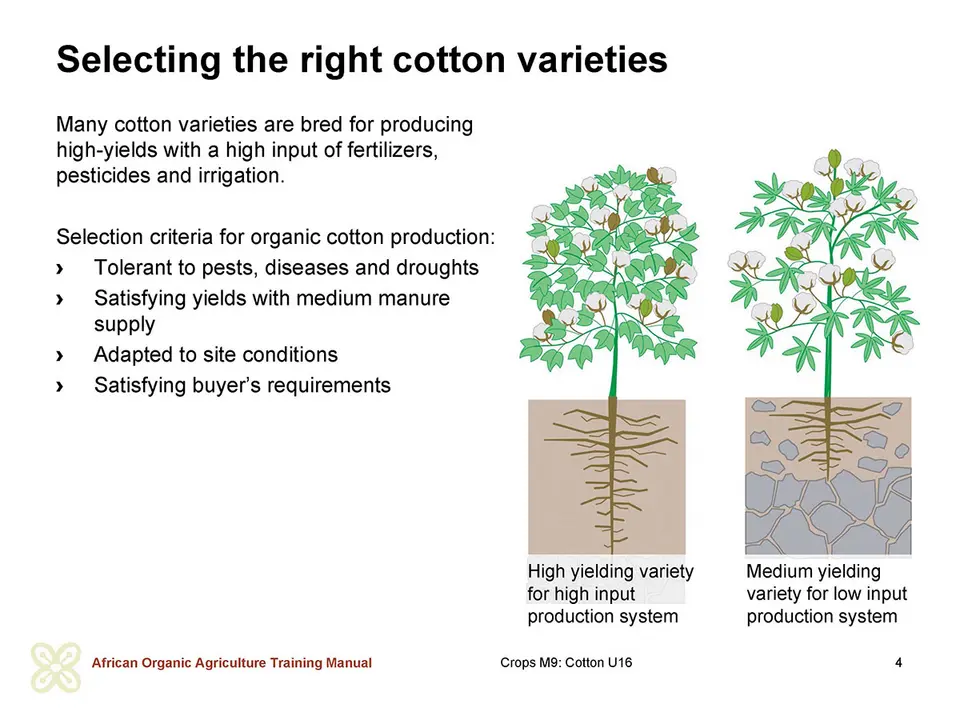Improving access to good quality seeds
Characteristics of variety and seed quality have a great influence on yields, plant health, climate change adaptation, nutrient uptake efficiency and adaptability to the soil, local climate conditions and lint quality. Access to good quality seed is, therefore, a prerequisite for successful cotton production.
Certified organic agriculture requires the use of seeds that have not been treated chemically, and that originate from multiplication on organic farms. The first requirement is usually met by organic cotton projects through the use of cotton seeds that have been exempted from chemical treatment. The second requirement – originating from organic production – cannot currently be met by most organic cotton projects in sub-Saharan Africa because of national legislation. However, certification bodies acknowledge these legal constraints and, therefore, accept by implication the use of conventionally but untreated seeds produced according to a well-established procedure.
Characterisation of available varieties
Inquire among the farmers about the locally available cotton varieties. What are their characteristics (e.g. yield potential, adaptability to local conditions, resistance to infection, lint quality)? Note the results on a table and agree with the farmers on the most suitable varieties for the local conditions.
The right variety for the right site
There are many different cotton varieties available on the seed market. Research stations and seed companies continuously release new varieties. Most of them are bred for producing high-yields with a high input of fertilizers, pesticides and irrigation. Organic farmers should, however, be more interested in robust varieties, which are resistant or tolerant to pests, diseases and droughts and produce satisfying yields of about 0.65 to 1 ton seed cotton per hectare, with medium manure supply.
To select the most suitable varieties, farmers need to consider the site conditions. This includes soil quality and availability of manure, availability of enough water from rain or irrigation as well as the prevalence of common pest and disease problems. Where irrigation is a constraint and rainfall is erratic, it is preferable to grow varieties, which require less water (meaning those making less leaf area). Lastly, the buyer’s requirements concerning staple length and other fibre quality aspects need to be considered.
Multiplication and treatment of cotton seeds
Most seed companies do not provide untreated seeds anymore and large seed companies are no longer offering non-genetically modified varieties. Therefore, organic cotton projects normally have challenges of ensuring a reliable supply of untreated seed material with good yield potential. Traditional knowledge and know-how on seed production at the farm level is slowly ‘drying’ up. Research institutes have also hardly had the means to assist organic farmers in breeding and developing appropriate and locally adapted seed.
Alternative treatment of seeds can help to reduce damage by pests and diseases caused before and during germination. Some suggested methods are: dipping in cow urine, coating with clay and cow dung or treatment with a suspension of beneficial microorganisms (Trichoderma or Bacillus subtilis). To enhance the uptake of nutrients, some organic farmers treat the seeds with a suspension of Azotobacter and phosphorus solubilising bacteria (PSB).
In practical terms, involvement of a supporting organization as an intermediary between the farmers, the seed company and the associated national research body to manage organic cotton seed production is needed. Under supervision of a support organization the individual farmers can produce cotton seed for the production requirements. However, farmers will need a specific training to successfully accomplish this. At least every 5 years, seed varieties need to be replaced.
For a cotton field of 500 acres, 1 acre of seed production area is required. For 1 hectare it is advised to use 20 to 30 kilograms of seeds according to the germination capacity of seeds. The corresponding seed production area is 500 to 700 m2.
GMO seeds are not allowed in organic agriculture
In organic agriculture, the use of genetically modified organisms (GMOs) is not allowed. Genetically engineered ‘Bt cotton’ seeds contain genes of the same microorganism Bacillus thuringiensis that is used in the biocontrol of many insect pests. The Bt cotton plant thus continuously produces an insecticide that prevents bollworms from feeding on it. However, success with Bt-cotton requires regular purchase of seeds and high inputs of fertilizers and pesticides. The other type of GMO cotton being promoted is tolerant against specific herbicides. So far, South Africa, Kenya and Burkina Faso have opted for GMO cotton production. In Burkina Faso, GM cotton is advancing very fast and has reached over 80 % in 2011. As seed procurement was traditionally organized by the cotton associations, the organic cotton producers set up their own breeding program in 2008 involving the national research program to assure untreated and non-GM seed quality. This was only possible through the involvement of well-organized farmer organizations. In Burkina Faso, the UNPCB—Union Nationale des Producteurs de Coton du Burkina—is supporting their organic cotton farmers in accessing appropriate seed.
We can learn from this case in West Africa that only a well-organized multi-stakeholder approach, involving cotton producers, the support agency (e.g. farmer organization, NGO, state, private seed, ginning or marketing organization) can bring satisfactory and practical solutions to the seed challenge. However, the key players remain the ginners, input suppliers (fertilizers, pesticides) together with government bodies.

 tap and then scroll down to the Add to Home Screen command.
tap and then scroll down to the Add to Home Screen command.